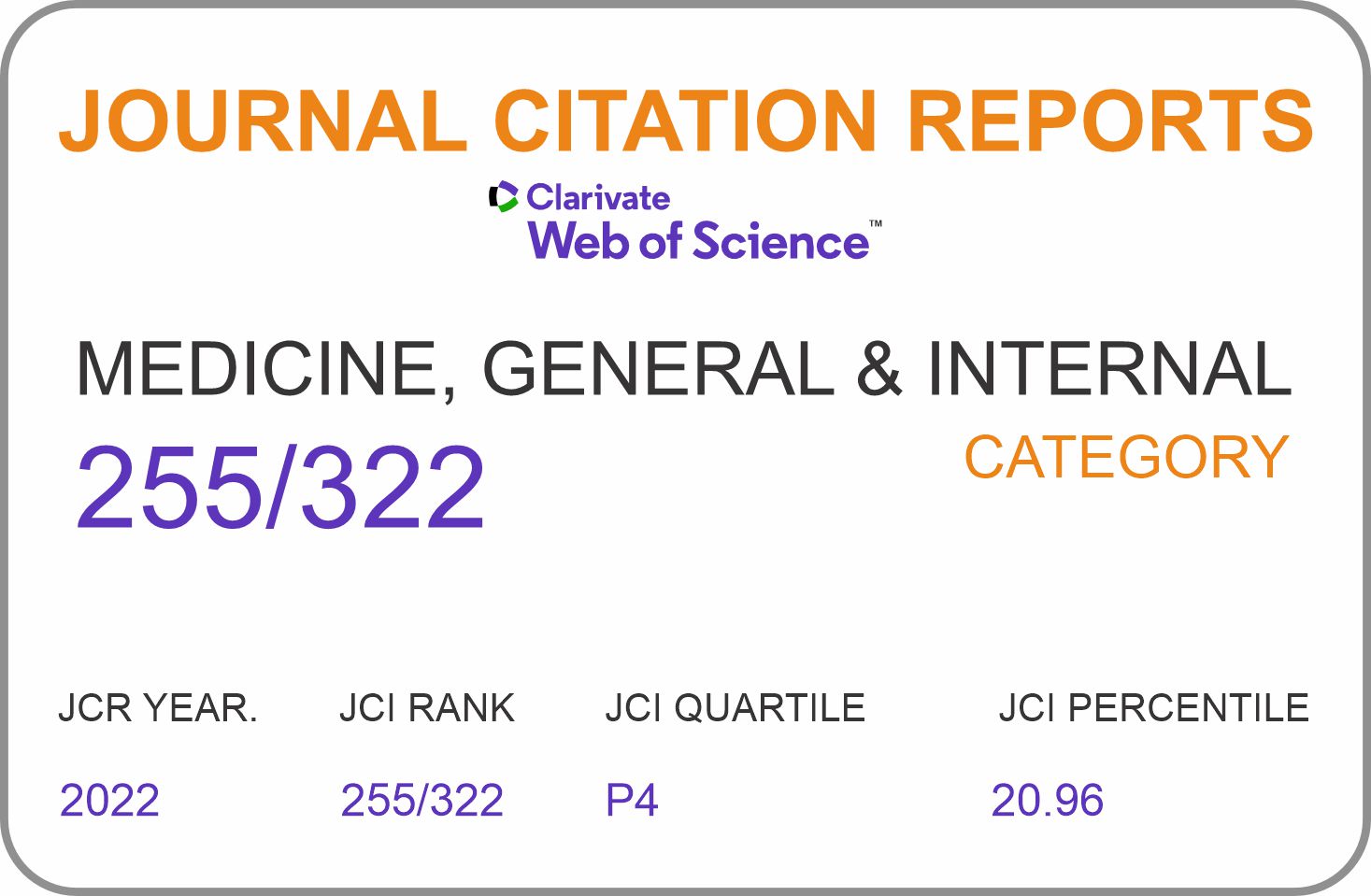Equation for total body water based on Watson's formula according to abdominal perimeter and age
DOI:
https://doi.org/10.35434/rcmhnaaa.2024.173.2458Keywords:
Body water, Linear models, Neural networks, computer, Waist circumference, AnthropometryAbstract
Objective: To develop a simplified anthropometric equation of total body water based on abdominal circumference and age based on Watson's formula.
Material and methods: Analytical and cross-sectional study, based on data from the 2022 national demographic health survey (population=32,066). The variables were: total body water, age, sex, abdominal perimeter. Neural networks (multilayer perceptron), multiple linear regression, and Spearman correlation were used to compare the results with the 2021 survey population (population=31,966).
Results: The multilayer perceptron had a relative error of 0.17 and 0.12 in women and men, respectively. The regression equation in women was: 8.083 + (0.308*abdominal circumference) + (-0.084*age). In men: 12.132 + (0.338*abdominal circumference) + (-0.166*age). The correlation of both equations was compared with a control group (ENDES-2021), finding very strong correlations in men (Rho=0.821) and women (Rho=0.816), similar to those of the main study (ENDES-2022) that had correlations of 0.897 and 0.845 in men and women, respectively.
Conclusions: The equation to determine total body water based on abdominal perimeter and age is highly close to Watson's original formula. As it does not require a scale, stadiometer, and is a more simplified equation, it could be applicable to large population groups as a screening instrument.
Downloads
Metrics
References
Young A, Brown LK, Ennis S, Beattie RM, Johnson MJ. Total body water in full-term and preterm newborns: systematic review and meta-analysis. Arch Dis Child Fetal Neonatal Ed. 2021 [citado 12 de abril de 2024];106(5):542–8. https://fn.bmj.com/content/106/5/542
Lu H, Ayers E, Patel P, Mattoo TK. Body water percentage from childhood to old age. Kidney Res Clin Pract [Internet]. 2023;42(3):340–8. http://dx.doi.org/10.23876/j.krcp.22.062
Brinkman JE, Dorius B, Sharma S. Physiology, Body Fluids [Internet]. StatPearls Publishing; 2023 [citado 12 de abril de 2024]. https://www.ncbi.nlm.nih.gov/books/NBK482447/
Tobias A, Ballard BD, Mohiuddin SS. Physiology, Water Balance [Internet]. StatPearls Publishing; 2022 [citado 12 de abril de 2024]. https://www.ncbi.nlm.nih.gov/books/NBK541059/
Nickerson BS, Narvaez SV, Juarez MI, Czerwinski SA. Effect of total body water estimates via bioimpedance on bod pod-based three-compartment body fat models. Eur J Clin Nutr. 2022 [citado 12 de abril de 2024];76(4):581–7. https://doi.org/10.1038/s41430-021-00982-7
Kim MJ, Lee SW, Kim GA, Lim HJ, Lee SY, Park GH, et al. Development of anthropometry-based equations for the estimation of the total body water in Koreans. J Korean Med Sci. 2005 [citado 12 de abril de 2024];20(3):445. http://dx.doi.org/10.3346/jkms.2005.20.3.445
Watson PE, Watson ID, Batt RD. Total body water volumes for adult males and females estimated from simple anthropometric measurements. Am J Clin Nutr [Internet]. 1980 [citado 12 de abril de 2024];33(1):27–39. Doi: 10.1093/ajcn/33.1.27
Martínez-Fernández G, Ortega Cerrato A, de la Vara Iniesta L, Oliver Galera E, Gómez Roldán C, Pérez Martínez J. Comparación entre bioimpedancia espectroscópica y fórmula de Watson para medición de volumen corporal en pacientes en diálisis peritoneal. Nefrologia. 2016 [citado 12 de abril de 2024];36(1):57–62. Doi: 10.1016/j.nefro.2015.11.002
Maskell PD, Jones AW, Heymsfield SB, Shapses S, Johnston A. Total body water is the preferred method to use in forensic blood-alcohol calculations rather than ethanol’s volume of distribution. Forensic Sci Int. 2020;316(110532):110532. http://dx.doi.org/10.1016/j.forsciint.2020.110532
Liu S, Feng Y, Zhang Q, Lu J, Li N, Liu Y, et al. Comparison of the Watson formula and bioimpedance spectroscopy for measuring body volume and calculating kt/V in patients with peritoneal dialysis. Ren Fail. 2024;46(1). http://dx.doi.org/10.1080/0886022x.2024.2313360
Instituto Nacional de Estadística e Informática [Internet]. Gob.pe. [citado 12 de abril de 2024]. https://www.gob.pe/institucion/inei/informes-publicaciones/4233597-peru-encuesta-demografica-y-de-salud-familiar-endes-2022
Lu H, Ayers E, Patel P, Mattoo TK. Body water percentage from childhood to old age. Kidney Res Clin Pract . 2023;42(3):340–8. Doi: 10.23876/j.krcp.22.062
Vega Abascal1 JB, Leyva Sicilia Y, Teruel Ginés R. La circunferencia abdominal. Su inestimable valor en la Atención Primaria de Salud. CCH Correo cient Holguín . 2019 [citado 31 de julio de 2023];23(1):270–4. http://scielo.sld.cu/scielo.php?script=sci_arttext&pid=S1560-43812019000100270
Hu YH, Yu SC, Qi X, Zheng WJ, Wang QQ, Yao HY. An overview of multiple linear regression model and its application. Zhonghua Yu Fang Yi Xue Za Zhi. 2019;53(6). Doi: 10.3760/cma.j.issn.0253-9624.2019.06.021
Schober P, Boer C, Schwarte LA. Correlation coefficients: Appropriate use and interpretation. Anesth Analg. 2018 [citado 12 de abril de 2024];126(5):1763–8. Doi: 10.1213/ANE.0000000000002864
Plataforma Nacional de Datos Abiertos [Internet]. Gob.pe. [citado 2 de octubre de 2023]. https://www.datosabiertos.gob.pe/
Gierach M, Gierach J, Ewertowska M, Arndt A, Junik R. Correlation between body mass index and waist circumference in patients with metabolic syndrome. ISRN Endocrinol. 2014 [citado 11 de abril de 2024];2014:1–6. http://dx.doi.org/10.1155/2014/514589
Dagan SS, Segev S, Novikov I, Dankner R. Waist circumference vs body mass index in association with cardiorespiratory fitness in healthy men and women: a cross sectional analysis of 403 subjects. Nutr J. 2013;12(1). http://dx.doi.org/10.1186/1475-2891-12-12
Wilmet G, Verlinde R, Vandevoorde J, Carnol L, Devroey D. Correlation between Body Mass Index and abdominal circumference in Belgian adults: a cross-sectional study. Rom J Intern Med [Internet]. 2017;55(1):28–35. http://dx.doi.org/10.1515/rjim-2016-0050
Staiano AE, Katzmarzyk PT. Visceral, subcutaneous, and total fat mass accumulation in a prospective cohort of adolescents. Am J Clin Nutr. 2022 [citado 12 de abril de 2024];116(3):780–5. https://pubmed.ncbi.nlm.nih.gov/35544287/
Mudie DM, Murray K, Hoad CL, Pritchard SE, Garnett MC, Amidon GL, et al. Quantification of gastrointestinal liquid volumes and distribution following a 240 mL dose of water in the fasted state. Mol Pharm. 2014 [citado 12 de abril de 2024];11(9):3039–47. Doi: 10.1021/mp500210c
Laaksonen DE, Nuutinen J, Lahtinen T, Rissanen A, Niskanen LK. Changes in abdominal subcutaneous fat water content with rapid weight loss and long-term weight maintenance in abdominally obese men and women. Int J Obes (Lond). 2003 [citado 12 de abril de 2024];27(6):677–83. Doi: 10.1038/sj.ijo.0802296
Guevara Tirado A. Correlación del agua corporal total con la edad en pacientes con y sin diabetes mellitus tipo-2 en la población peruana. Rev cient cienc salud. 2023 [citado 12 de abril de 2024];5:01–7. https://www.upacifico.edu.py:8043/index.php/PublicacionesUP_Salud/article/view/383
Downloads
Published
How to Cite
Issue
Section
Categories
License
Copyright (c) 2024 Alberto Guevara-Tirado

This work is licensed under a Creative Commons Attribution 4.0 International License.















